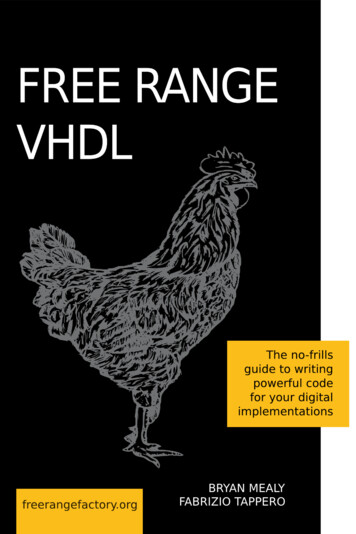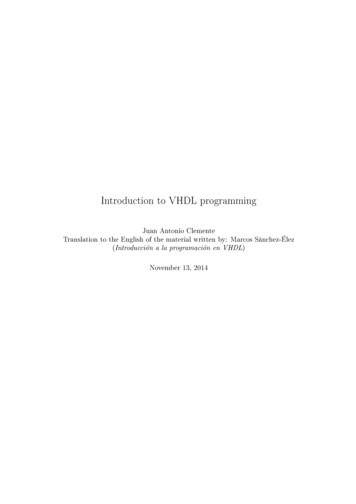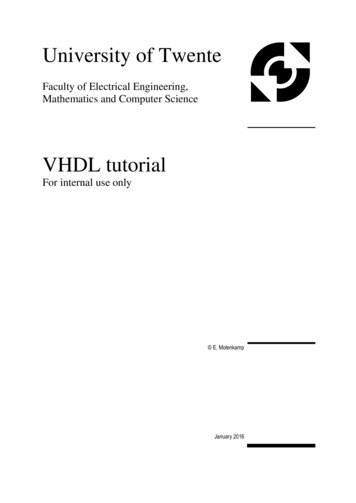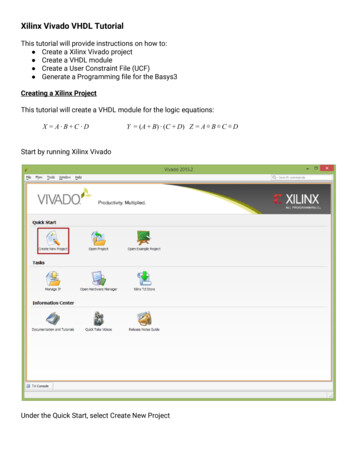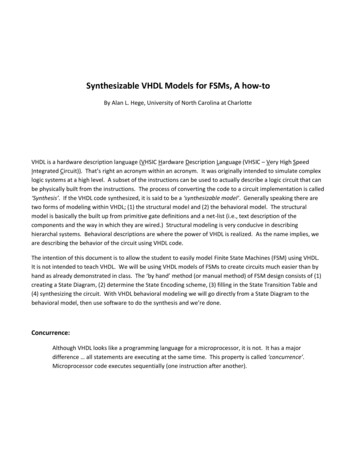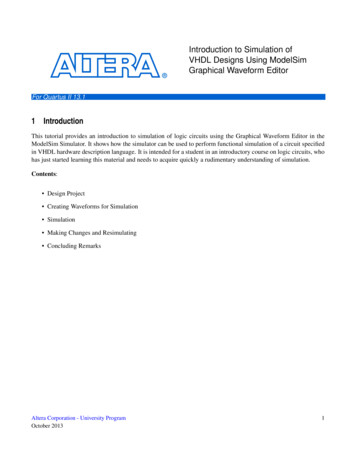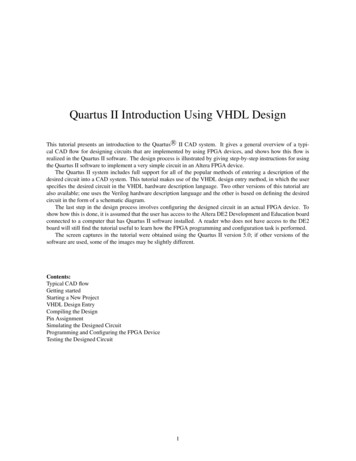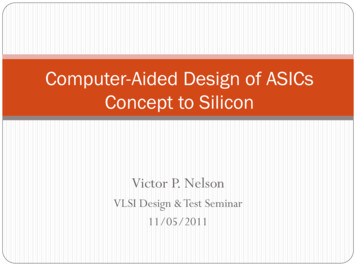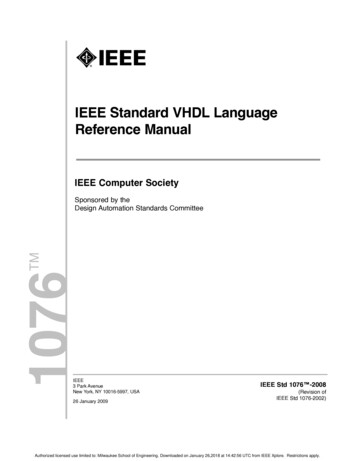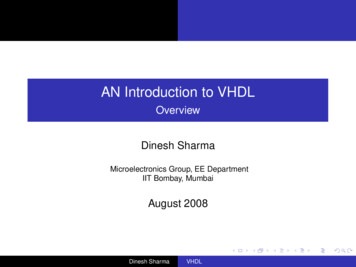
Transcription
AN Introduction to VHDLOverviewDinesh SharmaMicroelectronics Group, EE DepartmentIIT Bombay, MumbaiAugust 2008Dinesh SharmaVHDL
Design Units in VHDLObject and Data TypesPart IVHDL Design Units1Design Units in es and Libraries2Object and Data TypesScalar data typesComposite Data TypesDinesh SharmaVHDL
Design Units in VHDLObject and Data ges and LibrariesAn introduction to VHDLVHDL is a hardware description language which uses thesyntax of ADA. Like any hardware description language, it isused for many purposes.For describing hardware.As a modeling language.For simulation of hardware.For early performance estimation of system architecture.For synthesis of hardware.For fault simulation, test and verification of designs.etc.Dinesh SharmaVHDL
Design Units in VHDLObject and Data ges and LibrariesDesign Elements in VHDL: ENTITYThe basic design element in VHDL is called an ‘ENTITY’.An ENTITY represents a template for a hardware block.It describes just the outside view of a hardware module –namely its interface with other modules in terms of inputand output signals.The hardware block can be the entire design, a part of it orindeed an entire “test bench”.A test bench includes the circuit being designed, blockswhich apply test signals to it and those which monitor itsoutput.The inner operation of the entity is described by anARCHITECTURE associated with it.Dinesh SharmaVHDL
Design Units in VHDLObject and Data ges and LibrariesENTITY DECLARATIONThe declaration of an ENTITY describes the signals whichconnect this hardware to the outside. These are called portsignals. It also provides optional values of manifest constants.These are called generics.VHDL 93VHDL 87entity name isgeneric(list);port(list);end entity name;entity name isgeneric(list);port(list);end name;Dinesh SharmaVHDL
Design Units in VHDLObject and Data ges and LibrariesENTITY EXAMPLEVHDL 93VHDL 87entity flipflop isgeneric (Tprop:delay length);port (clk, d: in bit; q: out bit);end entity flipflop;entity flipflopgeneric (Tprop: delay length);port (clk, d: in bit; q: out bit);end flipflop;The entity declares port signals, their directions and data types.These signals are used by an architecture associated with thisentity.Dinesh SharmaVHDL
Design Units in VHDLObject and Data ges and LibrariesDesign Elements in VHDL: ARCHITECTUREAn ARCHITECTURE describes how an ENTITY operates. AnARCHITECTURE is always associated with an ENTITY.There can be multiple ARCHITECTURES associated with anENTITY.An ARCHITECTURE can describe an entity in a structuralstyle, behavioural style or mixed style.The language provides constructs for describing components,their interconnects and composition (structural descriptions).The language also includes signal assignments, sequential andconcurrent statements for describing data and control flow, andfor behavioural descriptions.Dinesh SharmaVHDL
Design Units in VHDLObject and Data ges and LibrariesARCHITECTURE SyntaxVHDL 93VHDL 87architecture name of entity-nameis(declarations)begin(concurrent statements)end architecture name;architecture name of entity-nameis(declarations)begin(concurrent statements)end architecture name;The architecture inherits the port signals from its entity. It mustdeclare its internal signals. Concurrent statements constitutingthe architecture can be placed in any order.Dinesh SharmaVHDL
Design Units in VHDLObject and Data ges and LibrariesARCHITECTURE ExampleVHDL 93VHDL 87architecture simple of dff issignal .;begin.end architecture simple;Dinesh Sharmaarchitecture simple of dff issignal .;begin.end simple;VHDL
Design Units in VHDLObject and Data ges and LibrariesDesign Elements in VHDL: COMPONENTSAn ENTITY ARCHITECTURE pair actually describes acomponent type.In a design, we might use several instances of the samecomponent type.Each instance of a component type may be distinguishedby using a unique name.Thus, a component instance with a unique instance nameis associated with a component type, which in turn isassociated with an ENTITY ARCHITECTURE pair.This is like saying U1 (component instance) is a D Flip Flop(component type) which is associated with an entity DFF(which describes its pin diagram) using architectureLS7474 (which describes its inner operation).Dinesh SharmaVHDL
Design Units in VHDLObject and Data ges and LibrariesComponent ExampleVHDL 93VHDL 87component name isgeneric(list);port(list);end component name;EXAMPLE:component flipflop isgeneric (Tprop:delay length);port (clk, d: in bit; q: out bit);end component flipflop;Dinesh Sharmacomponent namegeneric(list);port(list);end component;EXAMPLE:component flipflopgeneric (Tprop: delay length);port (clk, d: in bit; q: out bit);end component;VHDL
Design Units in VHDLObject and Data ges and LibrariesDesign Elements in VHDL: ConfigurationStructural Descriptions describe components and theirinterconnections.A component is an instance of a component type.Each component type is associated withan ENTITY ARCHITECTURE pair.The architecture used can itself contain other components whose type will then be associated with otherENTITY ARCHITECTURE pairs.A “configuration” describes linkages between componenttypes and ENTITY ARCHITECTURE pairs. It specifiesbindings for all components used in an architecture associatedwith an entity.Dinesh SharmaVHDL
Design Units in VHDLObject and Data ges and LibrariesDesign Elements in VHDL: PackagesRelated declarations and design elements like subprogramsand procedures can be placed in a ”package” for re-use.A package has a declarative part and an implementation part.This is somewhat like entity and architecture for designs.Objects in a package can be referred to by apackagename.objectname syntax.A description can include a ‘use’ clause to incorporate thepackage in the design. Objects in the package then becomevisible to the description without having to use the dot referenceas above.Dinesh SharmaVHDL
Design Units in VHDLObject and Data ges and LibrariesDesign Elements in VHDL: LibrariesMany design elements such as packages, definitions and entireentity architecture pairs can be placed in a library.The description invokes the library by first declaring it:For example,Library IEEE;Objects in the Library can then be incorporated in the design bya ‘use’ clause.For example,Use IEEE.std logic 1164.allIn this example, IEEE is a library and std logic 1164 is apackage in the library.Dinesh SharmaVHDL
Design Units in VHDLObject and Data TypesScalar data typesComposite Data TypesObject and Data Types in VHDLVHDL defines several types of objects. These includeconstants, variables, signals and files.The types of values which can be assigned to these objects arecalled data types.Same data types may be assigned to different object types.For example, a constant, a variable and a signal can all havevalues which are of data type BIT.Declarations of objects include their object type as well as thedata type of values that they can acquire.For examplesignal Enable: BIT;Dinesh SharmaVHDL
Design Units in VHDLObject and Data TypesScalar data typesComposite Data TypesData TypesScalarDiscreteFileAccessFloating Pt.IntegerrealenumerationSeverity ybit vectorstringbitcharacterbooleanfile open kindDinesh SharmaCompositefile open statusVHDL
Design Units in VHDLObject and Data TypesScalar data typesComposite Data TypesEnumeration TypeVHDL enumeration types allow us to define a set of values thata variable of this type can acquire. For example, we can definea data type by the following declaration:type instr is (add, sub, adc, sbb, rotl, rotr);Now a variable or a signal defined to be of type instr can onlybe assigned values enumerated above – that is: add, sub, adc,sbb, rotl and rotr.In actual implementation, these values may may be mapped toa 3 bit value. However, an attempt to assign, say, ‘010’ to avariable of type instr will result in an error. Only the enumeratedvalues can be assigned to a variable of this type.Dinesh SharmaVHDL
Design Units in VHDLObject and Data TypesScalar data typesComposite Data TypesPre-defined Enumeration TypesA few enumeration types are pre-defined in the language.These are:type bit is (’0’, ’1’);type boolean is (false, true);type severity level is (note, warning, error, failure);type file open kind is (read mode, write mode, append mode);type file open status is(open ok, status error, name error, mode error);In addition to these, the character type enumerates all theASCII characters.Dinesh SharmaVHDL
Design Units in VHDLObject and Data TypesScalar data typesComposite Data TypesTypes and SubTypesA signal type defined in the IEEE Library is std logic. This is asignal which can take one of 9 possible values. It is defined by:type std logic is (‘U’, ‘X’, ‘0’, ‘1’, ‘Z’, ‘W’, ‘L’, ‘H’, ‘-’);A subtype of this kind of signal can be defined, which can takethe four values ‘X’, ‘0’, ‘1’, and ‘Z’ only.This can be defined to be a subtype of std logicsubtype fourval logic is std logic range ‘X’ to ‘Z’;Similarly, we may want to constrain some integers to a limitedrange of values. This can be done by defining a new type:subtype bitnum is integer range 31 downto 0;Dinesh SharmaVHDL
Design Units in VHDLObject and Data TypesScalar data typesComposite Data TypesPhysical TypesObjects which are declared to be of Physical type, carry a valueas well as a unit. These are used to represent physicalquantities such as time, resistance and capacitance.The Physical type defines a basic unit for the quantity and maydefine other units which are multiples of this unit.Time is the only Physical type, which is pre-defined in thelanguage. The user may define other Physical types.Dinesh SharmaVHDL
Design Units in VHDLObject and Data TypesScalar data typesComposite Data TypesPre-defined Physical Type: Timetype time is range 0 to . . .unitsfs;ps 1000 fs;ns 1000 ps;us 1000 ns;ms 1000 us;sec 1000 ms;min 60 sec;hr 60 min;end units time;The user may define other physical types as required.Dinesh SharmaVHDL
Design Units in VHDLObject and Data TypesScalar data typesComposite Data TypesUser Defined Physical TypesAs an example of user defined Physical types, we can definethe resistance type.type resistance is range 0 to 1E9unitsohm;kohm 1000 ohm;Mohm 1000 kohm;end units resistance;Dinesh SharmaVHDL
Design Units in VHDLObject and Data TypesScalar data typesComposite Data TypesComposite Data TypesComposite data types are collections of scalar types.VHDL recognizes records and arrays as composite data types.Records are like structures in C.Arrays are indexed collections of scalar types. The index mustbe a discrete scalar type.Arrays may be one-dimensional or multi dimensional.Dinesh SharmaVHDL
Design Units in VHDLObject and Data TypesScalar data typesComposite Data TypesArraysArrays can be constrained or unconstrained.In constrained arrays, the type definition itself placesbounds on index values. For example:type byte is array (7 downto 0) of bit;type rotmatrix is array (1 to 3, 1 to 3) of real;In unconstrained arrays, no bounds are placed on indexvalues. Bounds are established at the time of declaration.type bus is array (natural range ) of bit;The declaration could be:signal addr bus: bus(15 downto 0);signal data bus: bus(7 downto 0);Dinesh SharmaVHDL
Design Units in VHDLObject and Data TypesScalar data typesComposite Data TypesBuilt in Array typesVHDL defines two built in types of arrays. These are:bit vectors and strings. Both are unconstrained.type bit vector is array (natural range ) of bit;type string vector is array (positive range ) of character;As a result we can directly declare:variable message: string(1 to 20)signal Areg: bit vector(7 downto 0)Dinesh SharmaVHDL
Design Units in VHDLObject and Data TypesScalar data typesComposite Data TypesRecordsWhile an array is a collection of the same type of objects,a record can hold components of different types and sizes.This is like a struct in C.The syntax of a record declaration containsa semicolon separated list of fields, each field having the formatname, . . ., name : subtypeFor example:type resource is record(P reg, Q reg : bit vector(7 downto 0); Enable: bit)end record resource;Dinesh SharmaVHDL
Structural DescriptionPart IIStructural Description in VHDL3Structural DescriptionComponent DeclarationsComponent InstantiationConfigurationRepetition GrammarDinesh SharmaVHDL
Structural DescriptionComponent DeclarationsComponent InstantiationConfigurationRepetition GrammarStructural StyleStructural style describes a design in terms of components andtheir interconnections.Each component declares its ports and the type and directionof signals that it expects through themHow can we describe interconnections between 5Outs5s6s3s4Dinesh SharmaVHDLp1p5p2U3p3p4p6
Structural DescriptionComponent DeclarationsComponent InstantiationConfigurationRepetition GrammarDescribing p5Outs5s6s3p1p5p2U3p3p4p6s4For each internal interconnect, wedefine an internal signal.When instantiating a component,we map its ports to specific internalsignals.For example, in the circuit above, At the time ofinstantiating U1, we map its pin p2 to signal s2.Similarly, when instantiating U2, we map its pin p3 to s2.This connects p2 of U1 to s2 and through s2 to pin p3 ofU2.Dinesh SharmaVHDL
Structural DescriptionComponent DeclarationsComponent InstantiationConfigurationRepetition GrammarStructural ArchitectureA purely structural architecture for an entity will consist of1Component declarations: to associate component typeswith their port lists.2Signal Declarations: to declare the signals used.3Component Instantiations: to place component instancesand to portmap their ports to signals. Signals can beinternal or port signals declared by the ENTITY.4Configurations: to bind component types to ENTITY ARCHITECTURE pairs.5Repetition grammar: for describing multiple instances ofthe same component type – for example, memory cells orbus buffers.Dinesh SharmaVHDL
Structural DescriptionComponent DeclarationsComponent InstantiationConfigurationRepetition GrammarComponent DeclarationsVHDL 93VHDL 87component name isgeneric(list);port(list);end component name;EXAMPLE:component flipflop isgeneric (Tprop:delay length);port (clk, d: in bit; q: out bit);end component flipflop;Dinesh Sharmacomponent namegeneric(list);port(list);end component;EXAMPLE:component flipflopgeneric (Tprop: delay length);port (clk, d: in bit; q: out bit);end component;VHDL
Structural DescriptionComponent DeclarationsComponent InstantiationConfigurationRepetition GrammarComponent InstantiationVHDL-93: Direct InstantiationVHDL-93 allows direct instantiation ofENTITY ARCHITECTURE pairs without having to go througha component type declaration first.Instance-name: entity entity-name (architecture-name)generic map(list)port map(list);This form is convenient, but does not have the flexibility ofassociating alternative ENTITY ARCHITECTURE pairs witha component.VHDL-87 does not allow direct instantiation.Dinesh SharmaVHDL
Structural DescriptionComponent DeclarationsComponent InstantiationConfigurationRepetition GrammarComponent InstantiationVHDL-93: Normal InstantiationInstance-name: component component-type-namegeneric map(list)port map(list);The association here is with a previously declared componenttype. The type will be bound to an ENTITY ARCHITECTUREpair using an inline configuration statement or a configurationconstruct.Dinesh SharmaVHDL
Structural DescriptionComponent DeclarationsComponent InstantiationConfigurationRepetition GrammarComponent InstantiationVHDL-87The keyword component is not used in VHDL-87. This isbecause direct instantiations are not allowed and therefore thebinding is always to a component.Instance-name: component-type-namegeneric map(list)port map(list);The association is with a previously declared component type.The type will be bound to an ENTITY ARCHITECTURE pairusing an inline configuration statement or construct.Dinesh SharmaVHDL
Structural DescriptionComponent DeclarationsComponent InstantiationConfigurationRepetition GrammarInline ConfigurationThe association between component types andENTITY ARCHITECTURE pairs can be made inline with ause clause.for all: component-nameuse entity entity-name(architecture-name);Instead of saying for all, we can specify a list of selectedinstances of this component type to which this binding willapply.instance-name-list: component-nameuse entity entity-name(architecture-name);Dinesh SharmaVHDL
Structural DescriptionComponent DeclarationsComponent InstantiationConfigurationRepetition GrammarThe key word OTHERSIf we use the keyword others instead of a list of instancenames, it refers to all component instances of thiscomponent-name which have not yet figured in a name-list.In VHDL, the key word others is used in different contextsinvolving lists.If some members of the list have been specified, then othersrefers to the remaining members. (If none was specified, it isequivalent to all.Dinesh SharmaVHDL
Structural DescriptionComponent DeclarationsComponent InstantiationConfigurationRepetition GrammarHierarchical ConfigurationWhen we associate a component type with a previously definedENTITY ARCHITECTURE pair,the chosen architecture could itself contain other components- and these components in turn would be associated with otherENTITY ARCHITECTURE pairs.This hierarchical association can be described by a standalonedesign unit called a configuration.Dinesh SharmaVHDL
Structural DescriptionComponent DeclarationsComponent InstantiationConfigurationRepetition GrammarHierarchical ConfigurationVHDL contains fairly complex configuration statements. Asimplified construct is introduced here:configuration config-name of entity-name isfor architecture-namefor component-instance-namelist: component-type-nameuse entity entity-name(architecture-name);end forend forend configuration config-name;Dinesh SharmaVHDL
Structural DescriptionComponent DeclarationsComponent InstantiationConfigurationRepetition GrammarStructural description: ExampleAABA BA BA BBLet us choose the xor gateshown on the left as anexample for structuraldescription.It uses four instances of asingle type of component: twoinput NAND.A BWe shall describe the NANDgate first.Dinesh SharmaVHDL
Structural DescriptionComponent DeclarationsComponent InstantiationConfigurationRepetition GrammarThe work libraryIn VHDL, as we describe entities and architectures, theseare compiled into a special library called WORK.This library is always included and does not have to bedeclared.In some sense, the WORK library represent the currentstate of development of the project for designingsomething.Dinesh SharmaVHDL
Structural DescriptionComponent DeclarationsComponent InstantiationConfigurationRepetition GrammarDefinition of NANDEntity nand2 isport (in1, in2: in bit; p: out bit);end entity nand2;We do not use any generic for thissimple example.Architecture trivial of nand2 isp not (in1 and in2);end Architecture trivial;‘not’ and ‘and’ are inbuilt logicalfunctions.(Actually so is nand – but we aretrying to be cute!)Now that we have this entity-architecture pair, we can use it tobuild our xor gate.Dinesh SharmaVHDL
Structural DescriptionComponent DeclarationsComponent InstantiationConfigurationRepetition GrammarXOR Gate exampleAAN1Bs1N2A Bs2A Bs1BUSE WORK.ALLEntity xor isport(a,b: in bit; axb: out bit);End Entity xor;s3s1N3A BN4axbA BDinesh SharmaArchitecture simple of xor iscomponent NAND2in IS port(a,b:in bit; axb: out bit);For all NAND2in: use EntityNAND2(Trivial);signal s1,s2,s3: bit;VHDL
Structural DescriptionComponent DeclarationsComponent InstantiationConfigurationRepetition GrammarXOR Architecture bodyAAN1Bs1N2A Bs2A Bs1Bs3s1N3A BN4axbA BDinesh SharmabeginN1: component NAND2inportmap(a, b, s1);N2: component NAND2inportmap(a, s1, s2);N3: component NAND2inportmap(b, s1, s3);N4: component NAND2inportmap(s2, s3, axb);end Architecture simple;VHDL
Structural DescriptionComponent DeclarationsComponent InstantiationConfigurationRepetition GrammarRepetition GrammarWe frequently use a large number of identical components ofthe same type. (For example memory cells or bus drivers).It is tedious to instantiate and configure each one of themindividually.VHDL provides a way to place a collection of instances of acomponent type at one go using the generate statement.Dinesh SharmaVHDL
Structural DescriptionComponent DeclarationsComponent InstantiationConfigurationRepetition GrammarGENERATE StatementThe generate statement contains a for loop which takes effectduring the circuit elaboration step. This can be used to repeatinstantiation constructs. We illustrate this statement with anexample:groupname: for index in 0 to width-1 generatebeginsome-name: component outbufportmap (.);end generate groupname;The defined index in the “for” construct has local scope and canbe used to pick specific signals from an array in portmapstatements.Dinesh SharmaVHDL
Structural DescriptionComponent DeclarationsComponent InstantiationConfigurationRepetition GrammarExample: Full adderC inabC outEntity FullAdder isFullAdder sum Port(a,b, C in: in bit; sum, C out: out bit);End Entity FullAdder;C out and sum represent the more significant and lesssignificant bits of a b C in.Dinesh SharmaVHDL
Structural DescriptionComponent DeclarationsComponent InstantiationConfigurationRepetition GrammarExample: Full adderC inabC outEntity FullAdder isFullAdder sum Port(a,b, C in: in bit; sum, C out: out bit);End Entity FullAdder;C out and sum represent the more significant and lesssignificant bits of a b C in.Suppose this is too difficult for the likes of us to figure outDinesh SharmaVHDL
Structural DescriptionComponent DeclarationsComponent InstantiationConfigurationRepetition GrammarExample: Full adderC inabC outEntity FullAdder isFullAdder sum Port(a,b, C in: in bit; sum, C out: out bit);End Entity FullAdder;C out and sum represent the more significant and lesssignificant bits of a b C in.Suppose this is too difficult for the likes of us to figure outWe would like to decompose the circuit into blocks whichhandle two bits at a time.Dinesh SharmaVHDL
Component DeclarationsComponent InstantiationConfigurationRepetition GrammarStructural DescriptionDecomposition of Full AdderHalf Adders2sHA2i1i2 cy cy2C inas s1HA1i1cy cy1i2sumcyi1C outcombnsi2Each half adder represents thesum and carry of just two bits.bThe combiner just combines thecarries from the two half adders.(Just an OR Gate will do it.)Dinesh SharmaCarry occurs only if both bits are 1.Sum is zero if both bits are zero orboth are one.so sum a xor b, cy a and b.VHDL
Structural DescriptionComponent DeclarationsComponent InstantiationConfigurationRepetition GrammarDescription of full AdderEntity HalfAdder isport(in1, in2: in bit; s, cy: out bit);End Entity HalfAdder;Architecture trivial of HalfAdder isbegins a xor b;cy a and b;end Architecture trivial;Dinesh SharmaArchitecture simple of FullAdder isComponent HalfAdder isport(a, b: in bit; s, cy: out bit);End Component HalfAdder;signal s1, cy1, cy2: bit;beginHA1: Component HalfAdderportmap(a,b,s1,cy1)HA2: Component HalfAdderportmap(s1,cy1,sum,cy2)Cmbn: Component OR2inportmap(cy1, cy2, C out)end Architecture simple;VHDL
Structural DescriptionComponent DeclarationsComponent InstantiationConfigurationRepetition GrammarThe half adderCarry from the half adder is an AND gate, and the combiner isan OR.i1i2But Gates without inversion are slow. So we bring out carryrather than carry, using a NAND gate.Entity HalfAdder isport(in1, in2: in bit; s, cybar: out bit);Half AdderEnd Entity HalfAdder;cybarArchitecture better of HalfAdder isbeginss a xor b;cybar a nand b;end Architecture better;The combiner should now be an OR of negative true signals.This is just a NAND.Dinesh SharmaVHDL
Structural DescriptionComponent DeclarationsComponent InstantiationConfigurationRepetition GrammarEfficient Full AddersC insums2HA2i1cybar c2bi2sas1C outHA1i1cybar c1bi2combnbDinesh SharmaArchitecture better of FullAdder isComponent HalfAdder isport(a, b: in bit; s, cybar: out bit);End Component HalfAdder;signal s1, c1b, c2b: bit;beginHA1: Component HalfAdderportmap(a,b,s1,c1b);HA2: Component HalfAdderportmap(s1,c1b,sum,c2b);Cmbn: Component NAND2inportmap(c1b, c2b, C out);end Architecture better;VHDL
Behavioural DescriptionSubprogramsAttributesPart IIIBehavioural Description Using VHDL4Behavioural DescriptionConcurrent StatementsVHDL OperatorsProcessesSequential Statements5Subprograms6AttributesArray attributesType AttributesSignal attributesDinesh SharmaVHDL
Behavioural DescriptionSubprogramsAttributesConcurrent StatementsVHDL OperatorsProcessesSequential StatementsBehavioural StyleBehavioural style describes a design in terms of its behaviour,and not in terms of a netlist of components.We describe behaviour through “if-then-else” type of constructs,loops, sequential and concurrent assignment statements.Statements like “if-then-else” are inherently sequential. Thesemust therefore occur only inside sequential bodies likeprocesses.A concurrent assignment statement may be considered as ashorthand for a very simple process.Dinesh SharmaVHDL
Behavioural DescriptionSubprogramsAttributesConcurrent StatementsVHDL OperatorsProcessesSequential StatementsSpecifying a waveformA waveform is described by a comma separated list of valuesand optionally, delays. For example, we may assign a waveformby a statement likeindata ’0’, ‘1’ AFTER 20 NS, ’0’ AFTER 50 NS;The values at different times are treated as transport delaysand are all inserted in the time ordered queue without wipingout earlier values.(This is the only context where delays are transport by default).Single value assignments use inertial delay by default.Dinesh SharmaVHDL
Behavioural DescriptionSubprogramsAttributesConcurrent StatementsVHDL OperatorsProcessesSequential StatementsConcurrent AssignmentA concurrent assignment can be made conditionally by using‘when’ clauses.name [delay-mechanism]waveform when Boolean-expression elsewaveform when Boolean-expression;The assignment is made from the first waveform where theBoolean expression evaluates to TRUE.Dinesh SharmaVHDL
Behavioural DescriptionSubprogramsAttributesConcurrent StatementsVHDL OperatorsProcessesSequential StatementsConcurrent AssignmentThe assignment can also be made on a selective basis, basedon the value of some expression:with expression selectname [delay-mechanism]waveform when choices,waveform when choices;If the expression evaluates to one of the specified choices, thecorresponding assignment is made.Dinesh SharmaVHDL
Behavioural DescriptionSubprogramsAttributesConcurrent StatementsVHDL OperatorsProcessesSequential StatementsAssignment to an aggregateAssignments can be made to a collection of signalssimultaneously. For example let vec be defined as bit vector(2downto 0)vec (“000”) - - 000 : stringvec (’0’,’0’,’1’) - - 001 : positionalvec (1 ’1’, others ’0’) - - 010 : named, partialvec (’1’, others ’0’) - - 100 : positional, partialvec (2 0 ′ 1′ , others ’0’) - - 101 : partialvec (others ’1’) - - 111Dinesh SharmaVHDL
Behavioural DescriptionSubprogramsAttributesConcurrent StatementsVHDL OperatorsProcessesSequential StatementsVHDL OperatorsLogical operators: AND, OR, NAND, NOR, OR, XNOR andNOTFor example x a xor b;Relational operators: , / , , , , and operate on any type. Others operate on arithmetictypes: (integers, reals etc.). All of these return a booleanvalue.Shift operators: SLL (logical left), SLA (arithmetic left) SRL(logical right), SRA (Arithmetic right), ROL rotate left andROR (rotate right).Dinesh SharmaVHDL
Behavioural DescriptionSubprogramsAttributesConcurrent StatementsVHDL OperatorsProcessesSequential StatementsProcessesSequential constructs need to be placed inside a process. Aprocess uses the syntax:[ process-label: ] process [(sensitivity-list)] [is][declarations]begin[sequential statements]end process [process-label];Sequential statements include “if” constructs, case statements,looping constructs, assertions, wait statements etc.Dinesh SharmaVHDL
Behavioural DescriptionSubprogramsAttributesConcurrent StatementsVHDL OperatorsProcessesSequential StatementsProcess with Sensitivity listEvery process is like an endless loop. Therefore, it requires anexplicit or implicit suspend statement.If a sensitivity list is given with the process statement, theprocess automatically suspends when it reaches its end.It restarts from the beginning when any of the signals in itssensitivity list has an event.This process has a static sensitivity and an implicit suspendstatement.Dinesh SharmaVHDL
Behavioural DescriptionSubprogramsAttributesConcurrent StatementsVHDL OperatorsProcessesSequential StatementsWait statementsA process without a sensitivity list requires explicit suspendstatements. These are provided by wait statements. These canbe of the form:wait for waiting-time;wait on signal-list;wait until waiting-condition;wa
Design Units in VHDL Object and Data Types entity Architecture Component Configuration Packages and Libraries An introduction to VHDL VHDL is a hardware description language which uses the syntax of ADA. Like any hardware description language, it is used for many purposes. For describing hardware. As a modeling language. For simulation of .File Size: 970KB
